Showing Aloha: Hawaii forges new food network, provides food boxes and prepares meals for needy families on Oahu

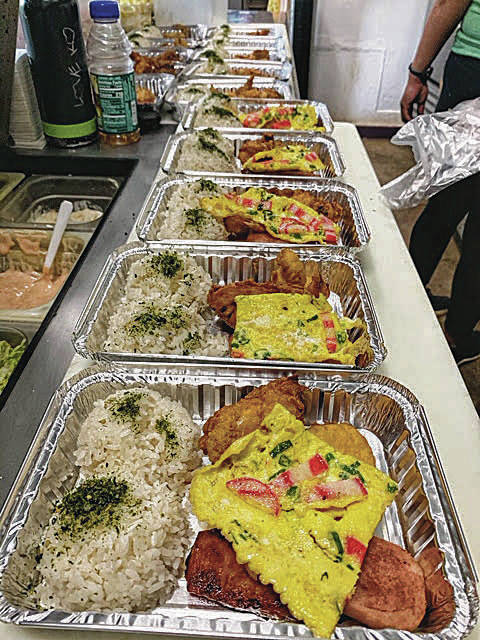
SHOW ALOHA COURTESY PHOTO
Above, food is lined up and ready for packing at Blue Ginger, a restaurant on Lanai. Restaurants contract to make 60 meals per day that go to needy seniors.
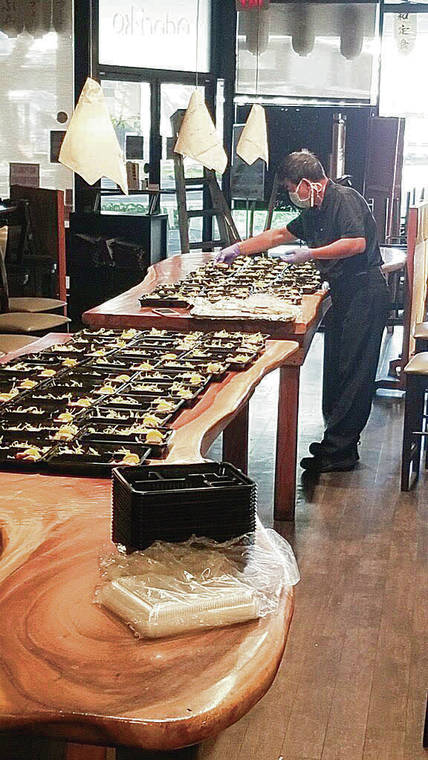
SHOW ALOHA COURTESY PHOTO
Food is prepared at Odori-ko Japanese restaurant in Honolulu, above.
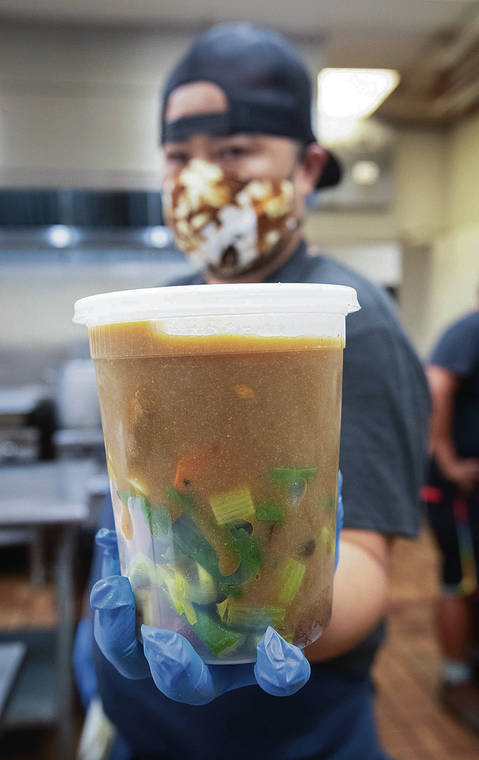
CINDY ELLEN RUSSELL / CRUSSELL@STARADVERTISER.COM
David Lukela holds one of 300 containers of venison curry to be distributed in food boxes.
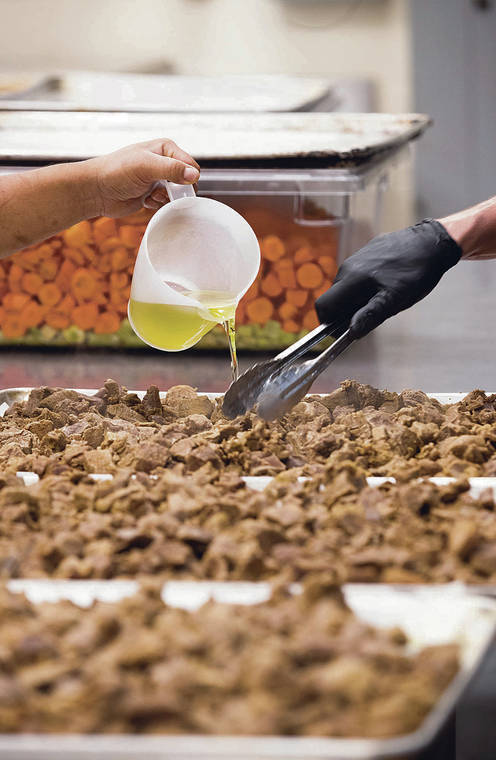
CINDY ELLEN RUSSELL / CRUSSELL@STARADVERTISER.COM
Above, braised venison pieces are arranged on trays before packaging.
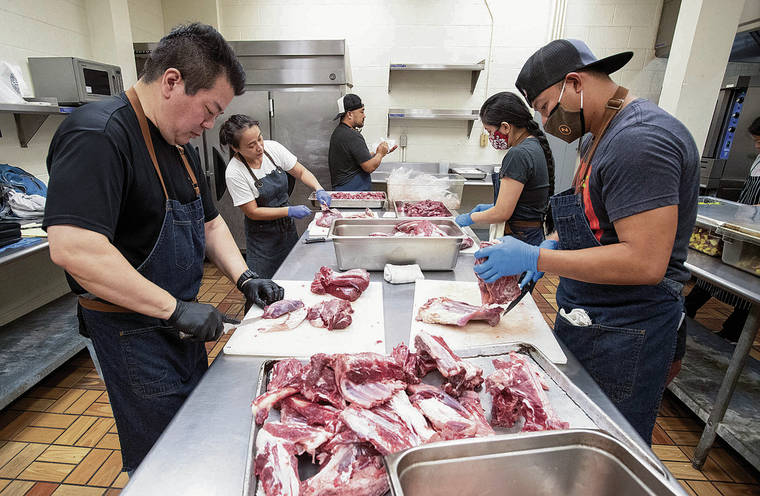
CINDY ELLEN RUSSELL / CRUSSELL@STARADVERTISER.COM
Paul Matsumoto, Alan Wong’s chef de cuisine, prepares venison for curry with volunteers at the Pacific Gateway Center. Pictured are Matsumoto, left, Regina Lapian, David Lukela, Camille Cadiz and Johnver Invencion.






Hot meals for homebound seniors, lunches for kids cut off from their school cafeterias, food boxes for newly needy families.
Just days after the world turned upside down, Hawaii forged a new food chain, born of need and sustained for weeks by a community eager to be of service.
At the front end were a few savvy organizers who pulled together massive networks of donors, delivery services and suddenly unemployed restaurant workers happy to return to the kitchen, often without pay. Not to mention hundreds of volunteers who sort produce, pack boxes and so much more.
All this came together among groups large and small, working separately, with no overall direction and little government involvement. If there’s anything to be learned from the coronavirus pandemic, it’s that when motivated, some of us can move at the speed of light.
“It evolved in 24 hours,” said Mike Gangloff, co-founder of Show Aloha Challenge, among the earliest and largest groups in the food chain.
Show Aloha’s model is to pay restaurants a stipend to produce meals for delivery to kupuna who can’t, or shouldn’t, go out. The program launched with $50,000 in seed money, mostly from Gangloff’s MIRA Image Construction Co.
Don't miss out on what's happening!
Stay in touch with breaking news, as it happens, conveniently in your email inbox. It's FREE!
In a week, Gangloff said, 10 mostly small restaurants were up and cooking, 60 meals each per day. “We were doing 600 meals a day for 10 days with that initial investment.”
Show Aloha has since raised more than $900,000 and is serving 1,400 meals a day, he said. More than 40 restaurants have taken a turn.
The campaign also draws donations of fresh food and dry goods, some of which goes to the restaurants to defray costs and some into food boxes — 2,000 were distributed in a drive-thru event last month, with another 250,000 pounds set for a giveaway June 2 at Aloha Stadium.
Gangloff’s partner, broadcast personality Lanai Tabura, said part of the reason the group could move so quickly was that it locked in corporate donors early. Many of them typically set aside money for community causes but had not yet been approached for coronavirus-related relief, Tabura said. “It put us at the top of the list, because it was an emergency.”
Feed-the-needy campaigns have been ongoing all over the state, some as small as a single restaurant setting aside a few dollars from every sale to put out meals for front-line medical workers.
Larger nonprofits have organized benefits for specific groups, such as the Hawaii Food & Wine Festival’s efforts to support the food industry’s unemployed.
The donor-restaurant-recipient model is among the most visible, viewed as a way to support struggling restaurants while serving recipients from keiki to kupuna.
Elena’s Restaurant in Waipahu has been making 60 meals a day for 50 days for Show Aloha — except for a 10-day period when the kitchen turned out 120 meals a day. “That was kinda nuts,” co-owner Mellissa Cedillo said.
But the $8-per-meal stipend coming at the beginning of the pandemic meant everything to her bottom line, Cedillo said. It bolstered takeout earnings from the restaurant and its food trucks so that she’s been able to keep all her employees on. “Having just that extra income every day put us at 100%.”
Chef Hui, run by the husband-wife team of Mark Noguchi and Amanda Corby Noguchi, recently launched the Give and Go Community Meal Program, which also provides stipends to restaurants to make meals daily for community groups islandwide.
With some guaranteed income, Corby Noguchi said, the hope is the eateries can stay open, paying their employees and suppliers. “It’s like a triple bottom line. It supports farmers, restaurants, and it feeds people.”
The Give and Go program is funded by nearly $100,000 in donations and will run at least through May.
Chef Lee Anne Wong signed up as soon as her Kaimuki restaurant, Koko Head Cafe, reopened for takeout. “I called Mark and said, ‘I’ve got bodies. Let us help,’” Wong said. Her staff will make 25 family-style meals for four, twice a week.
“We love and appreciate that opportunity.”
Give and Go is just the latest of Chef Hui’s efforts. The group has chefs working in five kitchens around Oahu — Pacific Gateway Center, Kona Brewing Co., Waipahu High School, Open Kitchen Oahu and Cakeworks — preparing meals that go wherever needed. Kona Brewing Co., for example, made more than 200 gallons of soup and stew in April.
Within days of when the pandemic was declared, the group mobilized to organize restaurant leftovers into food boxes for families; this evolved into a Feed the People initiative with the food distribution nonprofit Aloha Harvest. Feed the People is a major contributor to weekly food drives at four locations, serving 150 to 300 families per site.
With help from a number of produce distributors and other corporate donors that provide food and manpower — the hui has put out more than 40,000 of those chef- prepared meals, as well as produce bags that also include local beef or venison, eggs and milk, Corby Noguchi said.
Collaboration is key to these campaigns, making each day a juggling act for the central organizers.
“I haven’t worked in two months, and it feels like I have three jobs now, without pay,” Tabura said of his Show Aloha duties. Chief among them: “I’m, like, a professional beggar.”
The group has the funds to continue until mid-June, Tabura said, so he’s on the hunt for more.
Show Aloha partners with Hawaii Meals on Wheels to identify clients, accept donations and cut checks to the restaurants making the meals. Delivery is primarily handled by St. Francis Healthcare System of Hawaii.
Michelle Cordero-Lee, CEO of Meals on Wheels, said the group has gone from feeding 400 clients daily to more than 1,000, average age 86. “We were getting inundated with phone calls with these kupuna sheltering in.”
At Show Aloha, Gangloff and Tabura did what her organization could never have done alone, “using their business connections to shake trees for us,” Cordero-Lee said.
“Lanai and Mike and their group of private businesses saw food insecurity as the biggest issue we’d be grappling with during this health care crisis.”
As the economy reopens and people are able to move about again, needs might shift, but no one involved in these programs thinks the job will be done.
“We have to evolve the program and still get the food out to the people in need,” Mark Noguchi said.
For her part, Cedillo wants to keep Elena’s involved, even if she goes forward on her own. “I’ve always wanted a platform to feed the kupuna, and now that we have the experience and know we can handle it, now we can keep doing it.”
Tabura defines the work as “soul-defining” and not something he’ll give up easily.
On Mother’s Day he went out on some deliveries himself, to present bouquets of flowers to senior moms. What he thought was a small gesture brought many of the women to tears, he said. “I could only do five houses. I was an emotional wreck.”
HOW TO HELP
To donate cash or food, or to buy a benefit T-shirt:
>> Show Aloha Challenge: Go to show alohachallenge.com or call 356-2994.
>> Chef Hui: Go to chef hui.com Opens in a new tab. To participate as a restaurant, email chefhuihi@gmail.com.



